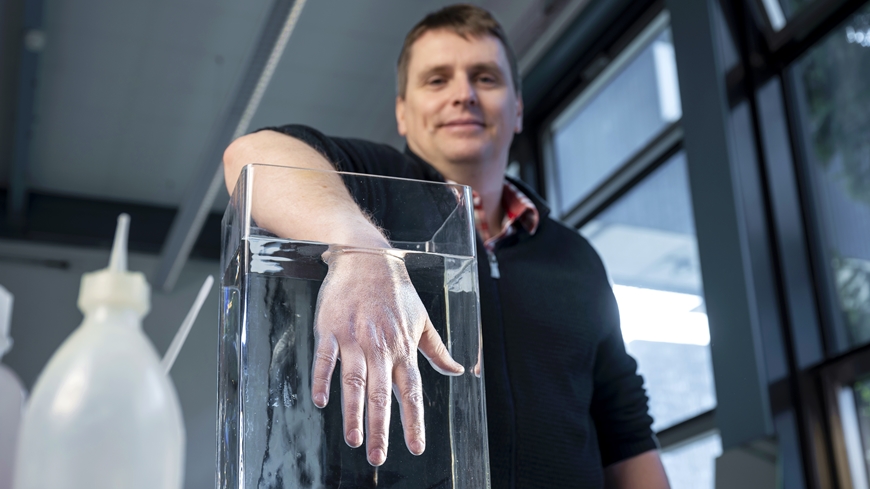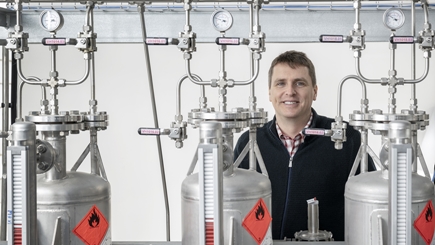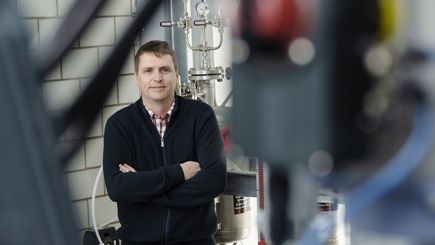Portrait Wim Malfait
He makes it light
Belgian-born Wim Malfait is a trained geologist who once searched for gold on behalf of a mining company. Today, he heads the Building Energy Materials and Components laboratory, which develops, among other things, super-lightweight aerogel insulation materials and materials with heat exchange capabilities. Saving energy as a social task – that is more important to him than gold.

As a teenager, Wim Malfait liked to collect stones on vacation and take them with him as a memento. Volcanic stone in particular fascinated the young Wim Malfait. Even then, he found the material side interesting. After the daunting preparations for the Math Olympiad as a teenager, Wim Malfait preferred to follow his hobby and enrolled in a geology degree program at Ghent University. In the master's program, he promptly landed in volcano research. Together with his fellow students, Wim Malfait conducted research on magma there under the same conditions as in the earth's interior - i.e. under high pressure and at temperatures of up to 1300 degrees Celsius. His expertise in silicate melting and in the use of measuring instruments, especially NMR spectroscopy, stems from this time.
After receiving his master's degree, Wim Malfait took a breather in the private sector. Away from any civilization, Wim Malfait worked for a mining company looking for gold. However, the harsh treatment of the people, and the lack of social benefit in the hunt for gold ("If only it had been copper...") made the young geologist quickly look the other way. What he took with him was the knowledge that success can be forced through collective goal orientation. After that, Wim Malfait worked briefly in soil remediation, where the rigid specifications seemed like excessive formalism to him. So he returned to research.
The right mix

A doctoral position then drew Wim Malfait to ETH Zurich, where he continued his research in the field of silicate melting. According to his own statements, Wim Malfait hit the jackpot with his doctoral supervisor at the time. "It was the ideal balance between taking an active interest and passively leaving space," says Wim Malfait today.
He came to Empa from ETH Zurich via a research project in the "Building Energy Materials and Components" laboratory. With the then head of laboratory Matthias Köbel, Wim Malfait found a similar balance between support and freedom. And his knowledge of metal-glass composites made him a valuable employee for the laboratory. Expertise with silicate melts has enabled Wim Malfait to contribute to the development of a new lower-cost process for producing aerogel. After just over a year at Empa, Wim Malfait became a group leader. And when Matthias Köbel devoted himself to his spin-off, Siloxene AG, and left Empa, Wim Malfait succeeded him.
Important social task
As laboratory head, Wim Malfait has practically laid-out goals. His mission for the lab is clear: to contribute to a reduction in the energy consumption of buildings. This involves not only focusing on insulating materials, but also on sorption materials, i.e. materials with heat exchange capabilities. Heating and cooling buildings plays an essential role in society's overall energy balance. "For me, research at Empa is characterized by the fact that you want to have - and should have - an impact on society."
In the meantime, Empa, and indeed Switzerland, has become home for Wim Malfait. With his wife and two sons, he spends as much free time as he can in nature to compensate.
Wim Malfait
Career: Initially environmental geologist and prospector for mineral resources, doctorate at ETH Zurich, then a decade of research on melts and volcanoes. Since 2013 at Empa.
Research: Main goal is to reduce energy demand for heating and cooling buildings by developing new high-performance insulation materials and sorbents – preferably based on biomass.
"Save to fail" culture

The fastest way to gain notoriety in academic circles, as everywhere else, is to publish positive results. It is important to Wim Malfait for his team that negative results do not represent defeats. More important than pure success, he says, is that researchers can pursue their own ideas. "Only through an open climate for creative ideas and a 'save to fail' culture do researchers come up with unconventional hypotheses from which entire laboratorys can develop," says Wim Malfait. That's why it's no problem if an experiment - or even two or three months of research - turns out to be a dead end. That's something that has to be endured.
When things go well
Pursuing science as a career brings with it certain emotional peculiarities. For ambitious young researchers, he says, it's not just an interest in research, the will to persevere and a certain sense of purpose that are important, but also a good dose of emotional resilience. "You should enjoy when things go well," the laboratory head thinks, "but you also shouldn't burst into total euphoria at every publication or fall into depression at every paper that gets rejected."
Measuring devices can also cause great emotions - and not only positive ones. For example, Wim Malfait worked for years with solid-state MNR spectroscopy. This instrument has accompanied Wim Malfait throughout his research career to the present day at Empa. "It's like a sibling I never wanted to have," says the scientist with a grin. From harmonious collaboration to total incomprehension and frustration, he says, it's all there.
Collaboration for success
As a rather young laboratory, Malfait and his team are dependent on cooperation within and outside Empa. Whether it's X-ray, endoscopy or other measurements, there is a lively exchange of equipment, expertise and even project ideas within Empa. It is one of the reasons why Wim Malfait likes it so much at Empa. He says the first reflex to inquiries at other labs is always, 'Yes, we should do that.' "My lab gets excellent support, from administration to engineering to custom parts," Malfait says.
So Wim Malfait really likes it at Empa - and he has arrived both professionally and privately. As head of laboratory, Wim Malfait is no longer quite as free as he was as a researcher. He can no longer let himself be driven by pure curiosity, and does not want to lose sight of the laboratory's goals - to develop and improve insulation and sorption materials for the benefit of society. But, what Wim Malfait gets in return for losing degrees of freedom is the knowledge that you are doing socially relevant research and helping the next generation of researchers develop. And that knowledge is a satisfaction all its own.
Wim Malfait's team
The Buildung Energy Materials and Components laboratory comprises about 25 researchers and works on high-performance insulation materials, including. Aerogel insulation materials for buildings offer extremely efficient thermal insulation and would have tremendous growth potential in the market. But because of its high cost, aerogel will never be able to replace traditional materials like mineral wool. So a cheaper solution that is sustainable is needed. Because only by moving from niche to mass can research results generate their full impact. Wim Malfait’s team is therefore looking for resource-saving insulating materials made from biowaste that provide similar insulating performance to conventional materials.
Dr. Wim Malfait
Building Energy Materials and Components
Phone: +41 58 765 4983
Dr. Michael Hagmann
Communication
Phone: +41 58 765 4592
redaktion@empa.ch
-
Share

| One peculiar pet |
|
The body is the house of the soul, as the philosopher Philon of Alexandria put it. In this house, the cochlea, the "snail", is our pet. Researchers at Empa's Center for X-ray Analytics, examined the cochleae using microcomputed tomography. |
| Relevant for all of us |
|
A successful implementation of Switzerland's Energy Strategy 2050, personalized medicine for our society and a competence center for quantum technologies – Tanja Zimmermann has set herself ambitious goals. The new director explains why her heart beats for Empa. |






